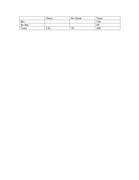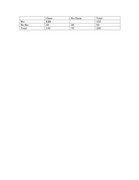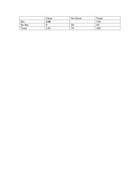Hi,
How can we solve this problem by using the double-matrix method?
OF the 200 students at College T majoring in one or more of the sciences, 130 are majoring in chemistry and 150 are majoring in biology. If at least 30 of the students are not majoring in either chemistry or biology, then the number of students majoring in both chemistry and biology could be any number from
A - 20 to 50
B 40 to 70
C - 50 to 130
D - 110 to 130
E - 110 to 150
Thanks!
Group problem
This topic has expert replies
- talaangoshtari
- Master | Next Rank: 500 Posts
- Posts: 154
- Joined: Wed May 21, 2014 4:29 am
- Thanked: 8 times
- Followed by:1 members
- DavidG@VeritasPrep
- Legendary Member
- Posts: 2663
- Joined: Wed Jan 14, 2015 8:25 am
- Location: Boston, MA
- Thanked: 1153 times
- Followed by:128 members
- GMAT Score:770
Who doesn't love a good matrix problem?
Start by inserting the concrete values. If there are 200 people total and 130 take Chemistry, that means 70 don't take Chemistry. Similarly, if there are 150 people taking Biology, 50 don't take Biology. So here's our starting matrix:

If we know that at least 30 take neither, we know that the No/Bio/No Chem cell must be AT LEAST 30. So that scenario gives us the following:

This gives us a low end of our range who take both, 110.
Next we want to maximize that No Bio/Bo Chem cell. Notice that we're limited by that total of 50 who don't take Bio. Therefore 50 is the largest possible number of students who take neither Biology nor Chemistry. So now we have this:
Now we have the high end of our range who take both, 130.
Answer is D

Start by inserting the concrete values. If there are 200 people total and 130 take Chemistry, that means 70 don't take Chemistry. Similarly, if there are 150 people taking Biology, 50 don't take Biology. So here's our starting matrix:

If we know that at least 30 take neither, we know that the No/Bio/No Chem cell must be AT LEAST 30. So that scenario gives us the following:

This gives us a low end of our range who take both, 110.
Next we want to maximize that No Bio/Bo Chem cell. Notice that we're limited by that total of 50 who don't take Bio. Therefore 50 is the largest possible number of students who take neither Biology nor Chemistry. So now we have this:
Now we have the high end of our range who take both, 130.
Answer is D

- GMATGuruNY
- GMAT Instructor
- Posts: 15539
- Joined: Tue May 25, 2010 12:04 pm
- Location: New York, NY
- Thanked: 13060 times
- Followed by:1906 members
- GMAT Score:790
Chemistry = 130 and Biology = 150.Of the 200 students at College T majoring in one or
more of the sciences, 130 are majoring in chemistry
and 150 are majoring in biology. If at least 30 of the
students are not majoring in either chemistry or
biology, then the number of students majoring in both
chemistry and biology could be any number from
(A) 20 to 50
(B) 40 to 70
(C) 50 to 130
(D) 110 to 130
(E) 110 to 150
Since 130+150 = 280 -- exceeding the total number of students by 80 -- at least 80 students must major in both subjects.
Eliminate A, B and C.
Since only 130 students major in chemistry, the number of students majoring in both subjects cannot exceed 130.
Eliminate E.
The correct answer is D.
Private tutor exclusively for the GMAT and GRE, with over 20 years of experience.
Followed here and elsewhere by over 1900 test-takers.
I have worked with students based in the US, Australia, Taiwan, China, Tajikistan, Kuwait, Saudi Arabia -- a long list of countries.
My students have been admitted to HBS, CBS, Tuck, Yale, Stern, Fuqua -- a long list of top programs.
As a tutor, I don't simply teach you how I would approach problems.
I unlock the best way for YOU to solve problems.
For more information, please email me (Mitch Hunt) at [email protected].
Student Review #1
Student Review #2
Student Review #3
Followed here and elsewhere by over 1900 test-takers.
I have worked with students based in the US, Australia, Taiwan, China, Tajikistan, Kuwait, Saudi Arabia -- a long list of countries.
My students have been admitted to HBS, CBS, Tuck, Yale, Stern, Fuqua -- a long list of top programs.
As a tutor, I don't simply teach you how I would approach problems.
I unlock the best way for YOU to solve problems.
For more information, please email me (Mitch Hunt) at [email protected].
Student Review #1
Student Review #2
Student Review #3
GMAT/MBA Expert
- Brent@GMATPrepNow
- GMAT Instructor
- Posts: 16207
- Joined: Mon Dec 08, 2008 6:26 pm
- Location: Vancouver, BC
- Thanked: 5254 times
- Followed by:1268 members
- GMAT Score:770
It's worth noting that David's Double Matrix approach can be used for most questions featuring a population in which each member has two characteristics associated with it.
Here, we have a population of students, and the two characteristics are:
- majoring in chemistry or not majoring in chemistry
- majoring in biology or not majoring in biology
This question type is VERY COMMON on the GMAT, so be sure to master the technique.
To learn more about the Double Matrix Method, watch our free video: https://www.gmatprepnow.com/module/gmat- ... ems?id=919
Once you're familiar with this technique, you can attempt these additional practice questions:
Easy Problem Solving questions
- https://www.beatthegmat.com/the-aam-aadm ... 72242.html
- https://www.beatthegmat.com/finance-majo ... 67425.html
Medium Problem Solving questions
- https://www.beatthegmat.com/probability- ... 73360.html
- https://www.beatthegmat.com/posted-speed ... 72374.html
- https://www.beatthegmat.com/motel-t271938.html
- https://www.beatthegmat.com/of-the-appli ... 70255.html
- https://www.beatthegmat.com/opening-nigh ... 64869.html
- https://www.beatthegmat.com/ds-french-ja ... 22297.html
- https://www.beatthegmat.com/prblem-solving-t279424.html
Difficult Problem Solving questions
- https://www.beatthegmat.com/ratio-problem-t268339.html
- https://www.beatthegmat.com/overlapping- ... 65223.html
- https://www.beatthegmat.com/fractions-t264254.html
- https://www.beatthegmat.com/overlapping- ... 64092.html
- https://www.beatthegmat.com/mba/2011/05/ ... question-2
Easy Data Sufficiency questions
- https://www.beatthegmat.com/for-what-per ... 70596.html
- https://www.beatthegmat.com/ds-quest-t187706.html
Medium Data Sufficiency questions
- https://www.beatthegmat.com/sets-matrix-ds-t271914.html
- https://www.beatthegmat.com/each-of-peop ... 71375.html
- https://www.beatthegmat.com/a-manufacturer-t270331.html
- https://www.beatthegmat.com/in-costume-f ... 69355.html
- https://www.beatthegmat.com/mba/2011/05/ ... question-1
Difficult Data Sufficiency questions
- https://www.beatthegmat.com/double-set-m ... 71423.html
- https://www.beatthegmat.com/sets-t269449.html
- https://www.beatthegmat.com/mba/2011/05/ ... question-3
Cheers,
Brent
Here, we have a population of students, and the two characteristics are:
- majoring in chemistry or not majoring in chemistry
- majoring in biology or not majoring in biology
This question type is VERY COMMON on the GMAT, so be sure to master the technique.
To learn more about the Double Matrix Method, watch our free video: https://www.gmatprepnow.com/module/gmat- ... ems?id=919
Once you're familiar with this technique, you can attempt these additional practice questions:
Easy Problem Solving questions
- https://www.beatthegmat.com/the-aam-aadm ... 72242.html
- https://www.beatthegmat.com/finance-majo ... 67425.html
Medium Problem Solving questions
- https://www.beatthegmat.com/probability- ... 73360.html
- https://www.beatthegmat.com/posted-speed ... 72374.html
- https://www.beatthegmat.com/motel-t271938.html
- https://www.beatthegmat.com/of-the-appli ... 70255.html
- https://www.beatthegmat.com/opening-nigh ... 64869.html
- https://www.beatthegmat.com/ds-french-ja ... 22297.html
- https://www.beatthegmat.com/prblem-solving-t279424.html
Difficult Problem Solving questions
- https://www.beatthegmat.com/ratio-problem-t268339.html
- https://www.beatthegmat.com/overlapping- ... 65223.html
- https://www.beatthegmat.com/fractions-t264254.html
- https://www.beatthegmat.com/overlapping- ... 64092.html
- https://www.beatthegmat.com/mba/2011/05/ ... question-2
Easy Data Sufficiency questions
- https://www.beatthegmat.com/for-what-per ... 70596.html
- https://www.beatthegmat.com/ds-quest-t187706.html
Medium Data Sufficiency questions
- https://www.beatthegmat.com/sets-matrix-ds-t271914.html
- https://www.beatthegmat.com/each-of-peop ... 71375.html
- https://www.beatthegmat.com/a-manufacturer-t270331.html
- https://www.beatthegmat.com/in-costume-f ... 69355.html
- https://www.beatthegmat.com/mba/2011/05/ ... question-1
Difficult Data Sufficiency questions
- https://www.beatthegmat.com/double-set-m ... 71423.html
- https://www.beatthegmat.com/sets-t269449.html
- https://www.beatthegmat.com/mba/2011/05/ ... question-3
Cheers,
Brent
-
Matt@VeritasPrep
- GMAT Instructor
- Posts: 2630
- Joined: Wed Sep 12, 2012 3:32 pm
- Location: East Bay all the way
- Thanked: 625 times
- Followed by:119 members
- GMAT Score:780
Another approach here. Since we have fewer people in chemistry than in biology, our MAXIMUM # of double majors comes if we assume that EVERY chemistry major is a double major. So we could have 130 double majors.talaangoshtari wrote:Hi,
How can we solve this problem by using the double-matrix method?
OF the 200 students at College T majoring in one or more of the sciences, 130 are majoring in chemistry and 150 are majoring in biology. If at least 30 of the students are not majoring in either chemistry or biology, then the number of students majoring in both chemistry and biology could be any number from
A - 20 to 50
B 40 to 70
C - 50 to 130
D - 110 to 130
E - 110 to 150
Thanks!
The other case is the MINIMUM, which is given in the problem (if exactly 30 students major in neither subject). That would give us 130 + 150 - (overlap) = (200 - 30), or an overlap of 110.
Hence it's 110 to 130, D, and we saved a lot of time!
-
gmatbeater1989
- Junior | Next Rank: 30 Posts
- Posts: 25
- Joined: Wed Oct 07, 2015 12:04 pm
Can I use the formua Group 1 + Group 2 + Neither - Both = Total here?talaangoshtari wrote:Hi,
How can we solve this problem by using the double-matrix method?
OF the 200 students at College T majoring in one or more of the sciences, 130 are majoring in chemistry and 150 are majoring in biology. If at least 30 of the students are not majoring in either chemistry or biology, then the number of students majoring in both chemistry and biology could be any number from
A - 20 to 50
B 40 to 70
C - 50 to 130
D - 110 to 130
E - 110 to 150
Thanks!
Is there a way to know when this formula works? I see it used some times and not others.
GMAT/MBA Expert
- [email protected]
- Elite Legendary Member
- Posts: 10392
- Joined: Sun Jun 23, 2013 6:38 pm
- Location: Palo Alto, CA
- Thanked: 2867 times
- Followed by:511 members
- GMAT Score:800
Hi gmatbeater1989,
Yes, you can use the Overlapping Sets Formula here (although it won't be applicable on every Overlapping Sets question that you might see).
This prompt comes with a couple of 'twists' to it:
1) The number of students who study 'neither' is NOT a fixed value - it's a range.
2) The question asks for the RANGE of students who could study both Chemistry and Biology.
Here's how you can use the Formula though...
Total = Gp.1 + Gp.2 - Both + Neither
200 = 130 + 150 - B + (>=30)
200 = 280 - B + (>=30)
200 = (>=310) - B
B = >=110
This gives you the 'lower end' of the range, but does not immediately give you the 'upper end.' To find that, you have to think about the numbers involved. Since 130 students study Chemistry and 150 study Biology, the MAXIMUM number who could study both would be 130 (and that's if EVERY Chemistry student also studied Biology). Thus, the range is 110 to 130, inclusive.
Final Answer: D
GMAT assassins aren't born, they're made,
Rich
Yes, you can use the Overlapping Sets Formula here (although it won't be applicable on every Overlapping Sets question that you might see).
This prompt comes with a couple of 'twists' to it:
1) The number of students who study 'neither' is NOT a fixed value - it's a range.
2) The question asks for the RANGE of students who could study both Chemistry and Biology.
Here's how you can use the Formula though...
Total = Gp.1 + Gp.2 - Both + Neither
200 = 130 + 150 - B + (>=30)
200 = 280 - B + (>=30)
200 = (>=310) - B
B = >=110
This gives you the 'lower end' of the range, but does not immediately give you the 'upper end.' To find that, you have to think about the numbers involved. Since 130 students study Chemistry and 150 study Biology, the MAXIMUM number who could study both would be 130 (and that's if EVERY Chemistry student also studied Biology). Thus, the range is 110 to 130, inclusive.
Final Answer: D
GMAT assassins aren't born, they're made,
Rich
-
gmatbeater1989
- Junior | Next Rank: 30 Posts
- Posts: 25
- Joined: Wed Oct 07, 2015 12:04 pm
Thanks Rich.[email protected] wrote:
Yes, you can use the Overlapping Sets Formula here (although it won't be applicable on every Overlapping Sets question that you might see).
So how do I know when the formula will work?





















